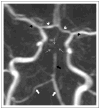Childhood basilar artery occlusion: a report of 5 cases and review of the literature
- PMID: 23670249
- PMCID: PMC4146487
- DOI: 10.1177/0883073813488826
Childhood basilar artery occlusion: a report of 5 cases and review of the literature
Abstract
Basilar artery occlusion has poor outcome in adults; little is known regarding outcomes in children. Whether intra-arterial treatments improve adult outcomes is controversial. Safety and efficacy of intra-arterial treatments in children are unknown. We report 5 cases of basilar artery occlusion and review published cases. We estimated National Institute of Health Stroke Scale (NIHSS) and modified Rankin Score (mRS) of published cases, compared scores between non-intra-arterial treatments and intra-arterial treatments groups, and examined the correlation between NIHSS and mRS. Of our cases, 4 had good outcomes and 1 died. Of 63 published cases, 45 had no intra-arterial treatments and 18 had intra-arterial treatments. In the non-intra-arterial treatments group 24 had good outcomes. In the intra-arterial treatments group 13 had good outcomes. There was strong correlation between the NIHSS and the mRS. Children with basilar artery occlusion have better outcomes than adults. Certain children with basilar artery occlusion may be treated conservatively. A registry for childhood basilar artery occlusion is urgently needed.
Keywords: National Institute of Health Stroke Scale; basilar artery occlusion; intra-arterial treatment; modified Rankin Score; thrombolysis..
Conflict of interest statement
MC has nothing to disclose. WDL is an editorial board member of the
Figures









Similar articles
-
Clinical and radiological predictors of recanalisation and outcome of 40 patients with acute basilar artery occlusion treated with intra-arterial thrombolysis.J Neurol Neurosurg Psychiatry. 2004 Jun;75(6):857-62. doi: 10.1136/jnnp.2003.020479. J Neurol Neurosurg Psychiatry. 2004. PMID: 15146000 Free PMC article.
-
Neurologic Examination at 24 to 48 Hours Predicts Functional Outcomes in Basilar Artery Occlusion Stroke.Stroke. 2016 Oct;47(10):2534-40. doi: 10.1161/STROKEAHA.116.014567. Epub 2016 Sep 1. Stroke. 2016. PMID: 27586683 Free PMC article.
-
Acute basilar artery occlusion treated with combined intravenous Abciximab and intra-arterial tissue plasminogen activator: report of 3 cases.Stroke. 2002 May;33(5):1424-7. doi: 10.1161/01.str.0000014247.70674.7f. Stroke. 2002. PMID: 11988626 Clinical Trial.
-
Thrombolysis in childhood stroke: report of 2 cases and review of the literature.Stroke. 2009 Mar;40(3):801-7. doi: 10.1161/STROKEAHA.108.529560. Epub 2008 Dec 31. Stroke. 2009. PMID: 19118242 Review.
-
Intra-arterial thrombolysis in acute basilar artery thromboembolism: the initial Mayo Clinic experience.Mayo Clin Proc. 1997 Nov;72(11):1005-13. doi: 10.4065/72.11.1005. Mayo Clin Proc. 1997. PMID: 9374973 Review.
Cited by
-
Recurrent basilar artery thrombectomy for pediatric vertebral dissection: illustrative case.J Neurosurg Case Lessons. 2025 Aug 18;10(7):CASE24523. doi: 10.3171/CASE24523. Print 2025 Aug 18. J Neurosurg Case Lessons. 2025. PMID: 40834434 Free PMC article.
-
Childhood acute basilar artery thrombosis successfully treated with mechanical thrombectomy using stent retrievers: case report and review of the literature.Childs Nerv Syst. 2017 Feb;33(2):349-355. doi: 10.1007/s00381-016-3259-z. Epub 2016 Oct 4. Childs Nerv Syst. 2017. PMID: 27704247 Review.
References
-
- Greving JP, Schonewille WJ, Wijman CA, Michel P, Kappelle LJ, Algra A. Predicting outcome after acute basilar artery occlusion based on admission characteristics. Neurology. 2012;78(14):1058–1063. - PubMed
-
- Mattle HP, Arnold M, Lindsberg PJ, Schonewille WJ, Schroth G. Basilar artery occlusion. Lancet Neurol. 2011;10(11):1002–1014. - PubMed
-
- Andersson T, Kuntze SA, Soderman M, Holmin S, Wahlgren N, Kaijser M. Mechanical thrombectomy as the primary treatment for acute basilar artery occlusion: experience from 5 years of practice. J Neurointerv Surg. 2013;5(3):221–225. - PubMed
-
- Tan ML, Mitchell P, Dowling R, Tacey M, Yan B. Shorter time to intervention improves recanalization success and clinical outcome post intra-arterial intervention for basilar artery thrombosis. J Clin Neurosci. 2012;19(10):1397–1400. - PubMed
-
- Schonewille WJ, Wijman CA, Michel P, et al. Treatment and outcomes of acute basilar artery occlusion in the Basilar Artery International Cooperation Study (BASICS): a prospective registry study. Lancet Neurol. 2009;8(8):724–730. - PubMed
Publication types
MeSH terms
Grants and funding
LinkOut - more resources
Full Text Sources
Other Literature Sources

